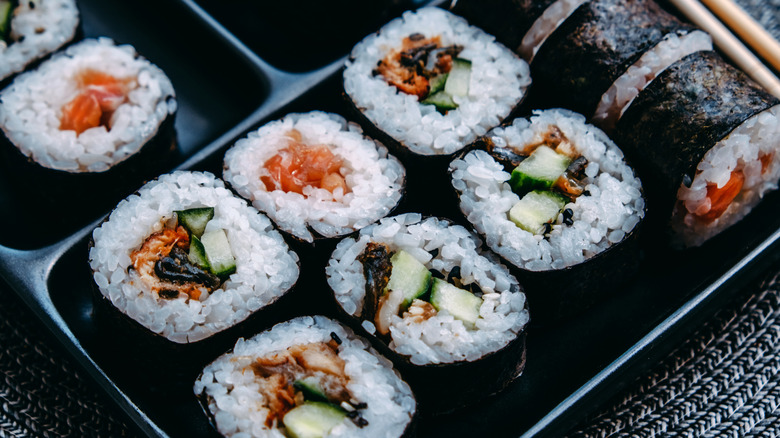One Step Keeps Nori Perfectly Crisp In Homemade Sushi Rolls
Sushi is an elegant, deceptively simple food that cleverly combines flavors and textures to create beautifully balanced bites of food. Though learning all the nuances of this centuries-old art can take more than a decade, making your favorite classic maki rolls at home is fairly easy and much more budget-friendly than ordering takeout. Maki rolls are what most people think of first when they picture sushi, as it features the classic combo of seafood and veggies nestled in the center of tasty layers of rice and seaweed paper, aka nori.
To get started making maki at home, all you have to do is make some sushi rice (you don't even have to wash the grains first!), julienne your fillings, tuck everything into a snug roll, and slice it into even pieces. Though there are a few pitfalls to watch out for during this process (e.g., soggy rice or overstuffing your rolls), among the most frustrating is soggy nori paper, which can make it harder to cut and ruin the texture of your meal.
Luckily, the solution is as easy as could be. Toasting your nori for literal seconds over a burner not only helps keep it nice and crisp, but it also makes the paper more flexible and easier to roll. If you have a gas stove, put the flame on low and wave the nori over the flame for between 5 and 10 seconds. If you don't have a gas stove, you can place the nori in a very hot oven (set to at least 400 degrees Fahrenheit) for the same length of time.
More tips for keeping your nori crisp
Toasting your nori is the best way to ensure it's crisp and ready for rolling. (As an added bonus, you can grind any extra toasted nori into a savory garnish.) However, storing your nori properly and preparing your sushi filling the right way can help ensure it stays crunchy and fresh throughout the sushi-making process. It's important to keep your nori paper in a cool, dry area to prevent it from soaking up moisture from the air in your kitchen. A dark cabinet inside a resealable plastic bag is ideal, especially if it's stored with other dry goods.
It's also vital to ensure your sushi rice is completely cool before assembling your sushi. As the rice cools, it releases steam that could easily ruin your nori paper. The same goes for fillings. If you're using watery veggies like cucumber or moist proteins like cooked shrimp, be sure to blot them as dry as you can before rolling your sushi, especially if you plan to make reverse maki, with the nori paper directly touching the fillings.
If you're making your maki ahead of time or have leftover rolls, note that the nori may absorb moisture as it sits in the fridge. To mitigate this, wrap your rolls in plastic cling wrap (not too tight) and then place them inside an airtight plastic storage container. The nori will still soften over time, but using this two-barrier storage method will help preserve its texture for a little bit longer.

